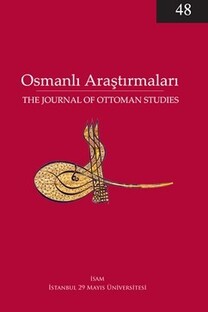Nasihatnameler, İcmal Defterleri, and the Timar-Holding Ottoman Elite in the Late Sixteenth Century-Part II, Including the Seventeenth Century
Bu çalışma timar sistemi üzerine Osmanlı Araştırmaları dergisinin 43. sayısında yayımlanmış olan makalemi tamamlayıcı mahiyettedir. On altıncı yüzyılda timar sistemi hakkındaki ilk makalede yer almayan bazı bilgiler ilave edilmiş ve on yedinci yüzyıldaki timar sistemi ele alınmıştır. Makale aynı zamanda eyalet kayıtlarında yer almayan timar meselesini incelemektedir. İcmal defterleri kullanılarak 1580-1632 yılları arasında eyalet kayıtlarından çıkarılan timarların miktarları tespit edilmeye çalışılmaktadır. Zira bu timarların paşmaklık veya ocaklık olarak harem kadınlarına ya da devlet hizmetinde bulunanlara verilmiş olmaları muhtemeldir. Eyaletlerdeki timarların sayılarında herhangi bir azalma olmadığı aksine sayıların arttığı gözlemlenmektedir. Ayrıca on yedinci yüzyıldaki timar sahiplerinin özellikleri incelenmekte ve timar sahiplerinin oğullarının on altıncı yüzyıldaki uygulamalara benzer şekilde aynı oranlarda timarlar kazandıkları gösterilmektedir. On yedinci yüzyılda sarayla ilişkili kişilerin timarları azalırken saray dışındakilerin timarları artmıştır.
NASİHATNAMELER, İCMAL DEFTERLERİ, AND THE TİMAR-HOLDINGPART II, INCLUDING THE SEVENTEENTH CENTURY
This paper is an addendum to my article on the timar system in a previous issue of this journal, carrying the story into the seventeenth century and adding data on the sixteenth century that was not in the previous article. It considers the question of timars not listed in the provincial registers, employing the icmal defterleri to determine how many timars disappeared from the provincial registers in the period 1580-1632, presumably because they were awarded to personnel such as harem women and officials as paşmaklık or ocaklık. It observes no decline in the number of provincial timars in that period, rather an increase. It also surveys the identities of seventeenth-century timar-holders, finding that the sons of timar-holders received timars in the same proportions as in the late sixteenth century. It was the people of the palace whose access to timars decreased in the seventeenth century, while that of the sons of nobodies increased.
___
Ágoston, Gabor: Guns for the Sultan: Military Power and the Weapons Industry in the Otto- man Empire, Cambridge: Cambridge University Press 2005.Akgündüz, Ahmed (ed.): "Ayn Ali'nin Kavânin-i ?l-i Osman'i," Osmanlı Kanunnâmeleri ve Hukukî Tahlilleri, Istanbul: Osmanlı Araştırmaları Vakfı 1996, vol. 9, pp. 25-86.
Barkan, Ömer Lütfi: "Timar," İslâm Ansiklopedisi, vol. 12, pp. 186-333.
Barkey, Karen: Bandits and Bureaucrats: The Ottoman Route to State Centralization, Ithaca: Cornell University Press 1994.
Car-Drnda, Hatid?a, "Remnants of the Tîmâr System in the Bosnian Vilâyet in the Second Half of the Nineteenth Century," International Journal of Turkish Studies, 10.1/2 (Fall 2004), pp. 171-74.
Clayer, Nathalie, "Note sure la survivance du système des timâr dans la region de Shkodër au début du XXe siècle," Turcica, 29 (1997), pp. 423-31.
Darling, Linda T.: "Nasîhatnâmeler, İcmal Defterleri, and the Ottoman Timar-Holding Elite in the Late Sixteenth Century," Osmanlı Araştırmaları, 43 (2014), pp. 193-226.
Emecen, Feridun M.: XVI. Asırda Manisa Kazâsı, Ankara: Türk Tarih Kurumu 1989.
Erdoğru, Mehmet Akif: "Akşehir Sancağındaki Dirliklerin III. Murat Devrindeki Durumu ve 1583/991 Tarihli Akşehir Sancağı İcmal Defteri," OTAM, 1, no. 1 (June 1990), pp. 127-62.
Evliya Çelebi: Narrative of Travels in Europe, Asia, and Africa, in the Seventeenth Century, Joseph von Hammer (trans.), London: Oriental Translation Fund 1834.
Hezarfen Hüseyin Efendi, Telhîsü'l-Beyân fî Kavânîn-i Âl-i Osmân, Sevim İlgürel (ed.), Ankara: Türk Tarih Kurumu 1998.
Howard, Douglas A.: "From Manual to Literature: Two Texts on the Ottoman Timar System," Acta Orientalia Academiae Scientiarum Hungaricae, 61 (2008), pp. 87-99.
.... , "The Ottoman Timar System and Its Transformation, 1563-1656," doctoral disserta- tion, Indiana University, 1987.
İnalcık, Halil: "Military and Fiscal Transformation in the Ottoman Empire, 1600-1700," Archivum Ottomanicum, 6 (1980), pp. 283-337.
Kolovos, Elias: "Beyond 'Classical' Ottoman Defterology: A Preliminary Assessment of the Tahrir Registers of 1670/71 concerning Crete and the Aegean Islands," Elias Kolovos, Phokion Kotzageorgeis, Sophia Laiou and Marinos Sariyannis (eds.): The Ottoman Empire, the Balkans, the Greek Lands: Toward a Social and Economic History: Studies in Honor of John C. Alexander, Istanbul: İsis Press 2007, pp. 201-35
Kunt, İ. Metin: The Sultan's Servants: The Transformation of Ottoman Provincial Govern- ment, 1550-1650, New York: Columbia University Press 1983.
Moa?anin, Nenad, "Defterology and Mythology: Ottoman Bosnia up to the Tanzîmat," International Journal of Turkish Studies, 10.1/2 (Fall 2004), 189-97.
Özkaya, Yücel: "XVIII. Yüzyılın Sonlarında Timar ve Zeâmetlerin Düzeni Konusunda Alınan Tedbirler ve Sonuçlar," Tarih Dergisi, 32 (1979), pp. 219-54 and plates pp. 959-77.
Soyudoğan, Muhsin: "Reassessing the Timar System: The Case Study of Vidin (1455- 1693)," doctoral dissertation, Bilkent University, 2012.
Zarinebaf, Fariba, John Bennet, and Jack L. Davis, with contributions by Evi Gorogianni, Deborah K. Harlan, Machiel Kiel, Pierre A. MacKay, John Wallrodt, and Aaron D. Wolpert: A Historical and Economic Geography of Ottoman Greece: The Southwestern Morea in the 18th Century, Hesperia Supplement 34, N.p.: American School of Clas- sical Studies at Athens 2005.
- ISSN: 0255-0636
- Yayın Aralığı: Yılda 3 Sayı
- Başlangıç: 1980
- Yayıncı: TDV İslâm Araştırmaları Merkezi
Sayıdaki Diğer Makaleler
Containing Sultanic Authority: Constitutionalism in the Ottoman Empire before Modernity
